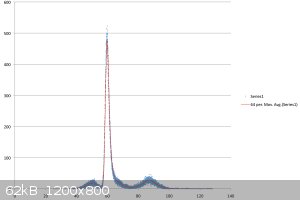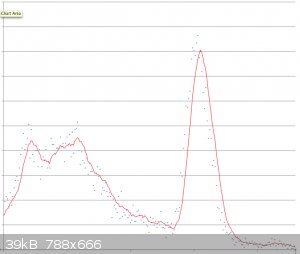Arcuritech
Harmless

Posts: 34
Registered: 19-8-2012
Location: Scraping fused boria from a crucible.
Member Is Offline
|
|
Geiger Tube Spectroscopy
I recently acquired a geiger counter containing a LND-712 tube and tested it with an Am-241 source. In order to get a more reliable count I ran the
output of the counter into my computer through the sound card, recorded and preprocessed in audacity, and counted in PRA. Out of curiosity I opened
the pulse hight and pulse with spectra and saw what looked like an Am-241 gamma spectrum buried under noise. After a lot of audacity fiddling I could
eventually coax this out of the data:

My theory is this happens because the counter itself is running the tube in the proportional or limited proportional discharge regime; this idea is
bolstered by the fact that I measured the voltage across the tube to be lower than the specifications listed in the tube's data sheet.
All of this has made me think that by undervolting the tube into the proportional counting region one could obtain reliable energy spectra, so I
intend to remove the tube from the counter and build my own driver and amplifier circuit to realize this. Any suggestions or words of advice regarding
this project would be appreciated, as I don't have all that much experience with gas discharge counting.
"If we knew what we were doing, it wouldn't be called research." -Albert Einstein
"There are few things -- whether in the outward world, or, to a certain depth, in the invisible sphere of thought -- few things hidden from the man
who devotes himself earnestly and unreservedly to the solution of a mystery." -Nathaniel Hawthorne ("Roger Chillingworth")
|
|
|
Ozone
International Hazard
    
Posts: 1269
Registered: 28-7-2005
Location: Good Olde USA
Member Is Offline
Mood: Integrated
|
|
I see you performed the energy calibration in PRA to the 59.5 keV gamma. I'll admit it does look like a proper Am-241 spectrum. How long was this
counted? The efficiency with a GM tube for gamma is extremely poor, even more so in the proportional range, despite the lower energy of the two
photons helping you out (greater interaction at lower energy).
I'd be interested in hearing more about how this data was acquired, processed, and the rig that was used.
FWIW, I'm currently using a Bicron 1.12X1.12x3/1.12 NaI(Tl) (FWHM = 8.5% @ 662 keV. Not great, but not bad at all for $100 USD) with a Gamma
Spectacular GS-1100-PRO and PRA (I use InTune to get the pulses in order).
Cheers,
O3
-Anyone who never made a mistake never tried anything new.
--Albert Einstein
|
|
|
Arcuritech
Harmless

Posts: 34
Registered: 19-8-2012
Location: Scraping fused boria from a crucible.
Member Is Offline
|
|
I am aware of the terrible efficiency of gas ionization detectors to gamma photons - that's why the spectrum in the picture is a 64 point moving
average and the sample time was 20 minutes.
The sample in question was a 1uCi Am-241 button from a dead smoke detector, and in order to get that good of a spectrum the sample had to be placed
nearly in direct contact with the end of the tube (the peaks from alpha particles were far higher in energy and did not interfere with the gamma
spectrum).
"If we knew what we were doing, it wouldn't be called research." -Albert Einstein
"There are few things -- whether in the outward world, or, to a certain depth, in the invisible sphere of thought -- few things hidden from the man
who devotes himself earnestly and unreservedly to the solution of a mystery." -Nathaniel Hawthorne ("Roger Chillingworth")
|
|
|
Ozone
International Hazard
    
Posts: 1269
Registered: 28-7-2005
Location: Good Olde USA
Member Is Offline
Mood: Integrated
|
|
Ah, OK, I figured it would require a long acquisition time. The oversampling is an interesting approach, though. Did you run FT?
You were running this without some sort of shield over the tube window? I'm assuming you exposed the source.
Anyhow, it's an impressive spectrum for a LEG using a GM. I'm sure others would be interested in hearing more or the details about how it was
done--spectroscopy with a cheap GM is not a trivial thing, and makes the technique even more accessible to low-budget investigation.
Also, I've been playing with indirect beta speciation via bremsstrahlung, so your technique may be of some use.
O3
-Anyone who never made a mistake never tried anything new.
--Albert Einstein
|
|
|
Arcuritech
Harmless

Posts: 34
Registered: 19-8-2012
Location: Scraping fused boria from a crucible.
Member Is Offline
|
|
FT? Do you mean a frequency spectrum from the raw signal? If so than yes I did - the signal from that old counter is very noisy and the
monstrous amount of processing that must be done to obtain useful data (along wit the opportunity to fine tune the operating voltage) is what made me
decide to scrap the whole driver/counter assembly and construct my own.
I did not shield the alpha radiation for a number of reasons.
- The energy of the y-rays involved is pretty low and the tube is inefficient I wanted to attenuate the photons as little as possible.
- The tube is longer than it is wide and therefore a y-ray has a higher chance of being captured if it has to travel the tube lengthwise - this is why
the sample was placed near the end window instead of the sidewall.
- I thought that if the tube really was measuring energy the a-particles shouldn't interfere with the y spectrum because the a-particles have so much
more energy they never show up in the same band (I mentioned this in a previous post but included it here for completeness).
As for the resolution of the spectrum: I was almost giddy with excitement when I saw that high resolution! It looks like something out of a
scintillation detector and the tube wasn't even operating at an ideal voltage for spectroscopy. Such promising results so early on in this line of
investigation are very encouraging.
On top of the Am-241 spectrum, I also took spectra of some other things. Cs-137 is often cited as a standard test source however the sample I measured
was not so active and I only had access to it for a short period of time so the spectrum I obtained - while still good - was nowhere near as
impressive as the Am-241 spectrum from my first post. Here it is:

"If we knew what we were doing, it wouldn't be called research." -Albert Einstein
"There are few things -- whether in the outward world, or, to a certain depth, in the invisible sphere of thought -- few things hidden from the man
who devotes himself earnestly and unreservedly to the solution of a mystery." -Nathaniel Hawthorne ("Roger Chillingworth")
|
|
|